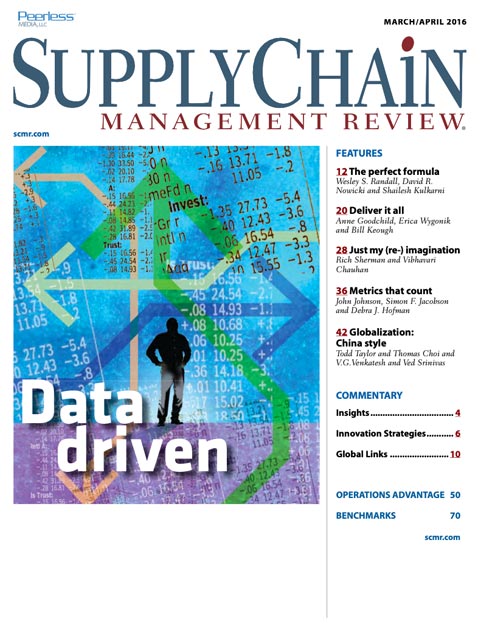Sorry, but your login has failed. Please recheck your login information and resubmit. If your subscription has expired, renew here.
March-April 2016
When I visit my millennial-aged daughter in Chicago, I’m amazed at the number of packages dropped off by UPS, FedEx and the USPS at her three-unit building on a daily basis. It’s as if she and her neighbors are single-handedly keeping Amazon in business. All those drop-offs got me to wondering: Does any of this make sense if you think about a carbon footprint? Rather than deliver millions of packages to one address at a time every day, wouldn’t it be more sustainable if we all just drove to the mall to do our shopping? After all, doesn’t research indicate that a signi cant percentage of consumers, especially millennial consumers like my… Browse this issue archive.Need Help? Contact customer service 847-559-7581 More options
It’s fair to say that no country has had as much impact on global supply chain management over the last 30 years as China has. As Larry Lapide wrote in the January 2016 issue of SCMR, low fuel prices in the 1980s helped create a “long supply chain” that stretched from Long Beach to Asia. “Companies altered their networks to embrace the integration and globalization of supply chains, leveraging cheap oil to minimize costs and inventories…Speeding up supply chains was the mantra followed to maintain customer response.”
China’s impact on global business continues to be felt today. While there is some talk of moving manufacturing closer to the point of demand, large manufacturing companies have identified supply management, and the need to continue to reduce the cost of parts, components and commodities, as a priority. That bodes well for low-cost countries with a developed manufacturing infrastructure like China. At the same time, we have all watched the stock market—and our 401(k)s—drop in value in recent months over concerns that China’s growth, along with its demand for commodities and raw materials, is on the wane.
Less noticed is the investments China is making to sustain its growth in emerging markets such as Africa, India, and Latin America—and its attempts to acquire industry leaders in the United States and Europe. Just last month, China National Chemical Corp. bid $43 billion to acquire Syngenta AG, the Swiss pesticide and seed giant.
What does it all mean? That’s the question posed in the following two essays.
 |
This complete article is available to subscribers
only. Click on Log In Now at the top of this article for full access. Or, Start your PLUS+ subscription for instant access. |
SC
MR
Sorry, but your login has failed. Please recheck your login information and resubmit. If your subscription has expired, renew here.
March-April 2016
When I visit my millennial-aged daughter in Chicago, I’m amazed at the number of packages dropped off by UPS, FedEx and the USPS at her three-unit building on a daily basis. It’s as if she and her neighbors are… Browse this issue archive. Access your online digital edition. Download a PDF file of the March-April 2016 issue.
 |
Download Article PDF |
It's fair to say that no country has had as much impact on global supply chain management over the last 30 years as China has. As Larry Lapide wrote in the January 2016 issue of SCMR, low fuel prices in the 1980s helped create a “long supply chain” that stretched from Long Beach to Asia. “Companies altered their networks to embrace the integration and globalization of supply chains, leveraging cheap oil to minimize costs and inventories…Speeding up supply chains was the mantra followed to maintain customer response.”
China's impact on global business continues to be felt today. While there is some talk of moving manufacturing closer to the point of demand, large manufacturing companies have identified supply management, and the need to continue to reduce the cost of parts, components and commodities, as a priority. That bodes well for low-cost countries with a developed manufacturing infrastructure like China. At the same time, we have all watched the stock market—and our 401(k)s—drop in value in recent months over concerns that China's growth, along with its demand for commodities and raw materials, is on the wane.
Less noticed is the investments China is making to sustain its growth in emerging markets such as Africa, India, and Latin America—and its attempts to acquire industry leaders in the United States and Europe. Just last month, China National Chemical Corp. bid $43 billion to acquire Syngenta AG, the Swiss pesticide and seed giant.
What does it all mean? That's the question posed in the following two essays.
 |
SUBSCRIBERS: Click here to download PDF of the full article. |
SC
MR

Latest Supply Chain News
- Few executives believe their supply chains can respond quickly to disruptions
- Technology’s role in mending supply chain fragility after recent disruptions
- Tech investments bring revenue increases, survey finds
- Survey reveals strategies for addressing supply chain, logistics labor shortages
- Israel, Ukraine aid package to increase pressure on aerospace and defense supply chains
- More News
Latest Podcast

 Explore
Explore
Topics
Latest Supply Chain News
- Few executives believe their supply chains can respond quickly to disruptions
- Technology’s role in mending supply chain fragility after recent disruptions
- Tech investments bring revenue increases, survey finds
- Survey reveals strategies for addressing supply chain, logistics labor shortages
- Israel, Ukraine aid package to increase pressure on aerospace and defense supply chains
- How CPG brands can deliver on supplier diversity promises
- More latest news
Latest Resources

Subscribe

Supply Chain Management Review delivers the best industry content.

Editors’ Picks





